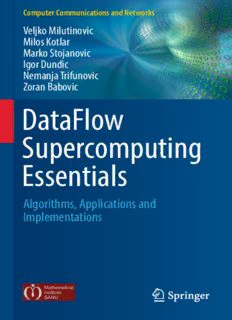
DataFlow Supercomputing Essentials: Algorithms, Applications and Implementations PDF
Preview DataFlow Supercomputing Essentials: Algorithms, Applications and Implementations
Computer Communications and Networks Veljko Milutinovic Milos Kotlar Marko Stojanovic Igor Dundic Nemanja Trifunovic Zoran Babovic DataFlow Supercomputing Essentials Algorithms, Applications and Implementations Computer Communications and Networks Serieseditor A.J.Sammes CentreforForensicComputing CranfieldUniversity,ShrivenhamCampus Swindon,UK The Computer Communications and Networks series is a range of textbooks, monographs and handbooks. It sets out to provide students, researchers, and non- specialists alike with a sure grounding in current knowledge, together with comprehensibleaccesstothelatestdevelopmentsincomputercommunicationsand networking. Emphasis is placed on clear and explanatory styles that support a tutorial approach, so that even the most complex of topics is presented in a lucid and intelligiblemanner. Moreinformationaboutthisseriesathttp://www.springer.com/series/4198 Veljko Milutinovic • Milos Kotlar Marko Stojanovic • Igor Dundic Nemanja Trifunovic • Zoran Babovic DataFlow Supercomputing Essentials Algorithms, Applications and Implementations 123 VeljkoMilutinovic MilosKotlar SchoolofElectricalEngineering SchoolofElectricalEngineering UniversityofBelgrade UniversityofBelgrade Belgrade,Serbia Belgrade,Serbia MarkoStojanovic IgorDundic SchoolofElectricalEngineering UniversityofBern UniversityofBelgrade Bern/Fribourg/Neuchâtel Belgrade,Serbia Switzerland NemanjaTrifunovic ZoranBabovic MaxelerTechnologies SchoolofElectricalEngineering London,UK UniversityofBelgrade Belgrade,Serbia ISSN1617-7975 ISSN2197-8433 (electronic) ComputerCommunicationsandNetworks ISBN978-3-319-66124-7 ISBN978-3-319-66125-4 (eBook) DOI10.1007/978-3-319-66125-4 LibraryofCongressControlNumber:2017951392 ©SpringerInternationalPublishingAG2017 Thisworkissubjecttocopyright.AllrightsarereservedbythePublisher,whetherthewholeorpartof thematerialisconcerned,specificallytherightsoftranslation,reprinting,reuseofillustrations,recitation, broadcasting,reproductiononmicrofilmsorinanyotherphysicalway,andtransmissionorinformation storageandretrieval,electronicadaptation,computersoftware,orbysimilarordissimilarmethodology nowknownorhereafterdeveloped. Theuseofgeneraldescriptivenames,registerednames,trademarks,servicemarks,etc.inthispublication doesnotimply,evenintheabsenceofaspecificstatement,thatsuchnamesareexemptfromtherelevant protectivelawsandregulationsandthereforefreeforgeneraluse. Thepublisher,theauthorsandtheeditorsaresafetoassumethattheadviceandinformationinthisbook arebelievedtobetrueandaccurateatthedateofpublication.Neitherthepublishernortheauthorsor theeditorsgiveawarranty,expressorimplied,withrespecttothematerialcontainedhereinorforany errorsoromissionsthatmayhavebeenmade.Thepublisherremainsneutralwithregardtojurisdictional claimsinpublishedmapsandinstitutionalaffiliations. Printedonacid-freepaper ThisSpringerimprintispublishedbySpringerNature TheregisteredcompanyisSpringerInternationalPublishingAG Theregisteredcompanyaddressis:Gewerbestrasse11,6330Cham,Switzerland Preface Ingeneral,thetwomajorapproachestocomputingare:controlflowanddataflow. In the control-flow approach, the program micro-controls the flow of data through the hardware. In the dataflow approach, the program configures the hardware; in theory, it is the voltage difference between the input and output of the hardware thatmicro-controlstheflowofdatathroughthehardwareinthetheoreticallyideal dataflowmachines(inreality,fornow,thistheoreticalidealhasnotbeenachieved yet). DataflowProgramming The most effective approach to dataflow is the one in which a dataflow machine serves as an accelerator. Only such approaches are the subject of the rest of this text. This means that the basic application continues to run on the classical controlflow machine; only the execution of time-consuming loops gets moved to the dataflow accelerator. This goal is implemented as follows: loops that satisfy specific conditions get extracted, skins get inserted instead (send data and receive results),andthenthekernelsgetwritten(typically,oneperloopextracted),which explainthesemanticsofthelooptothedataflowcompiler. DataflowCompilation One enters a dataflow compiler with one or more kernel programs (responsible for algorithm), one manager program (responsible for communications), and a few more utility programs (responsible for related logistics). In the first step, the compiler generates an execution graph, which is characterized with edges that are v vi Preface asshortaspossible,sincethatensuresgoodspeedandlowpowerconsumption.In thesecondstep,theexecutiongraphsgettranslatedintoabinaryfilethatconfigures thehardware. ProgrammingMaxeler One has to prepare the abovementioned programs (kernel(s), manager, etc.) in a DSL (domain-specific language). If Maxeler dataflow machines are used, the DSL to be used is Maxeler Java. Maxeler Java is a superset of the classical Java, with extensions going into two different directions: (a) a large number of built- in Java classes that enable the programmers to be more effective and (b) a new set of variables; classical java variables, referred to here as software variables, are responsibleforprocessesthattakeplaceatcompiletime;thenewsetofvariables, referred to here as hardware variables, physically flow through the hardware and producetheresultofinterestfortheapplicationdomain. ApplicationIssues Therearefourthingsthatonecando,inordertomaximizeperformance.Onecan (a) reform the input data choreography, (b) utilize the internal pipelines generated by the compiler in its effort to ensure the integrity of the code in conditions when different data items use different data paths, (c) use the changes in the algorithm (association,distribution,commutation),and(d)tunetheprecision,especiallyifthe floating-pointcomputationisused. Conclusion Theeffectivenessofdataflowcomputingdependsonvariousfactors:(a)thehigher the contribution of loops to the overall code run time, the higher the acceleration that the dataflow concept brings, especially if the level of data reusability within loopishighandifdataarrivesequentiallyinastream,and(b)themoreskillfulthe programmer,thebettertheutilizationoftheissuesdiscussedearlierinthistext.In conclusion,theprogrammingofdataflowmachinesisnotmoredifficult;onlymore up-fronttrainingisneeded. Belgrade,Serbia VeljkoMilutinovic July2017 Contents PartI Algorithms 1 ImplementingNeuralNetworksbyUsingtheDataFlowParadigm.... 3 1.1 Introduction ............................................................. 3 1.2 ExistingSolutions....................................................... 4 1.3 EssenceofthedataflowParadigm...................................... 6 1.4 ArtificialNeuralNetworks ............................................. 11 1.5 SingleLayerPerceptron ................................................ 14 1.5.1 Algorithm ....................................................... 14 1.5.2 ThedataflowImplementation.................................. 18 1.6 MultilayerPerceptronAlgorithm....................................... 27 1.6.1 BackpropagationAlgorithm.................................... 28 1.6.2 ThedataflowImplementation.................................. 31 1.7 PerformanceEvaluation ................................................ 39 1.7.1 SingleLayerPerceptron........................................ 39 1.7.2 MultilayerPerceptron .......................................... 40 1.8 Conclusion .............................................................. 42 References..................................................................... 44 PartII Applications 2 SolvingthePoissonEquationbyUsingDataFlowTechnology.......... 47 2.1 Introduction ............................................................. 47 2.2 MathematicalBackground.............................................. 48 2.2.1 BoundaryConditions........................................... 50 2.3 OverviewofExistingSolutions ........................................ 51 2.3.1 FourierTechniques ............................................. 52 2.3.2 IterativeTechniques ............................................ 56 2.3.3 MultigridTechniques........................................... 63 vii viii Contents 2.4 OverviewoftheGoalSolution......................................... 65 2.4.1 MaxelerdataflowComputingTechnologyConcept........... 65 2.4.2 ConditionsofApplicability .................................... 68 2.4.3 ImplementationDetails......................................... 68 2.4.4 UserGuide...................................................... 79 2.5 Measurements,Results,andPerformances............................ 81 2.6 PracticalApplicability.................................................. 86 2.6.1 Astrophysics .................................................... 87 2.6.2 Electrostatics.................................................... 87 2.6.3 BiologyandRelatedDisciplines............................... 88 2.6.4 TeamBehaviorAnalysis........................................ 88 2.6.5 OtherApplications.............................................. 89 2.7 Conclusion .............................................................. 90 References..................................................................... 91 3 BinarySearchintheDataFlowParadigm ................................ 93 3.1 Introduction ............................................................. 93 3.2 SystemRealizationRequirements...................................... 94 3.2.1 TheProblem .................................................... 94 3.2.2 AboutMaxelerTechnology .................................... 94 3.2.3 ConditionsandAssumptions................................... 95 3.2.4 ExistingSolutions .............................................. 95 3.3 AlgorithmDescription.................................................. 95 3.3.1 DataPreparation................................................ 95 3.3.2 BinarySearchAlgorithm....................................... 95 3.4 DataFlowAlgorithmRealization....................................... 97 3.4.1 KernelCode..................................................... 97 3.4.2 CCode .......................................................... 99 3.4.3 ManagerCode .................................................. 102 3.5 PerformanceAnalysis................................................... 104 3.5.1 TestResults ..................................................... 104 3.5.2 LongerInputSequenceAnalysis............................... 105 3.5.3 BottleneckAnalysis ............................................ 105 3.6 Conclusion .............................................................. 106 References..................................................................... 107 PartIII Implementations 4 IntroductoryOverviewonImplementationTools........................ 111 4.1 IntroductiontodataflowProgramming ................................ 111 4.2 DataFlowEngines(DFEs)andMaxJProgramming .................. 112 4.3 PortingaProgramtodataflowSystem................................. 113 4.3.1 ProgramAnalysis............................................... 115 4.3.2 EvaluatingDifferentArchitecturalOptions ................... 117 4.3.3 ImplementingtheKernels...................................... 117 Contents ix 4.3.4 IntegrationoftheAcceleratedKernelsBackintothe OriginalProgram ............................................... 117 4.3.5 DebuggingandOptimizingtheImplementationtoGet MaximalPerformance.......................................... 118 4.4 Interfaces ................................................................ 118 4.4.1 SAPISingle-DFESingle-ActionInterface.................... 119 4.4.2 MAPIMultipleActionInterface............................... 119 4.4.3 DAPIDFECreationAPI....................................... 119 4.5 ToolsOverview.......................................................... 120 4.5.1 Maxtop .......................................................... 120 4.5.2 MaxIDE......................................................... 120 4.5.3 MaxPower....................................................... 120 4.5.4 MonitoringDashboard.......................................... 121 4.5.5 Maxdebug....................................................... 121 4.5.6 Sliccompile...................................................... 123 4.5.7 MaxSkins(DFEsSpeakYourLanguage)...................... 124 4.5.8 MaxOrchestrator................................................ 125 References..................................................................... 125 5 DataFlowSystems:FromTheirOriginstoFutureApplications inDataAnalytics,DeepLearning,andtheInternetofThings.......... 127 5.1 Introduction ............................................................. 127 5.2 High-PerformanceComputingTechnology............................ 128 5.2.1 StateoftheControl-FlowTechnology......................... 128 5.2.2 Special-PurposeSystems....................................... 129 5.2.3 DataFlowSystems.............................................. 129 5.2.4 DataFlowLanguages ........................................... 131 5.2.5 SystolicArchitecture ........................................... 131 5.2.6 MultiscaledataflowComputingApproach .................... 133 5.3 IdeasforNewApplicationsofdataflowSystems...................... 137 5.3.1 SoftwareDistributeddataflowSystemsforBigData Analytics ........................................................ 137 5.3.2 IntegrationofMDCSystemwithApacheSpark.............. 138 5.3.3 DeepLearningApplications ................................... 142 5.3.4 TheInternetofThingsApplications........................... 144 5.4 Conclusion .............................................................. 146 References..................................................................... 147 Index............................................................................... 149
Description: